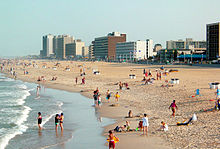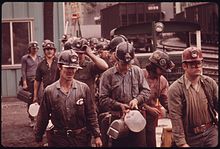Economy of Virginia
 Seal of Virginia | |
| Statistics | |
|---|---|
| GDP | $508,662,000,000[1] |
GDP per capita | $54,244[2] |
Population below poverty line | 10.2%[3] |
| 0.456 [4] | |
Labor force | 4,348,371[5] |
| Unemployment | 3.4%[6] |
| Public finances | |
| Revenues | $16,411,055,000[7] |
| Expenses | $40,024,000,000 [8] |
The economy of the Commonwealth of Virginia is well balanced with diverse sources of income. From the Hampton Roads area to Richmond and down to Lee County in the southwest includes military installations, cattle, tobacco and peanut farming in Southside Virginia. Tomatoes recently surpassed soy as the most profitable crop in Virginia. Tobacco, peanuts and hay are also important agricultural products from the commonwealth.[9] Wineries and vineyards in the Northern Neck and along the Blue Ridge Mountains also have become increasingly popular. Northern Virginia (once considered the state's dairy capital) hosts software, communications, consulting, defense contracting, diplomats, and considerable components of the professional government sector. As of the 2000 census, Virginia had the highest number of counties and independent cities (15) in the top 100 wealthiest jurisdictions in the United States based upon median income, in addition, Virginia tied with Colorado as having the most counties (10) in the top 100 based on per capita income. Loudoun and Fairfax counties in Northern Virginia have the highest and second highest median household income, respectively, of all counties in the United States as of 2017[update].



Background

The state GDP of Virginia was $383 billion in 2007, higher than the larger state of Michigan[10] and comparable to Saudi Arabia.[11] The per capita personal income was $35,477 in 2004. As of 2000[update], Virginia had the highest number of counties and independent cities, fifteen, in the top one-hundred wealthiest jurisdictions in the United States based upon median income. In addition, Virginia tied with Colorado as having the most counties, ten, in the top one-hundred based on per capita income.[12]
In 2006 and 2007, Forbes magazine voted Virginia as having the best climate for business in the United States citing economic growth, business costs/incentives and quality of life.[13] CNBC ranked Virginia as the top state for business in 2007 as well.[14]
Richmond is one of 12 cities in the country having a Federal Reserve bank. It, along with the New York and San Francisco Federal Reserve banks are the only ones that cover a non-state (Washington, D.C.).
There are seven Fortune 500 companies headquartered in Northern Virginia, and nine in the Richmond area (most of which are within the city itself.) Only five metro areas in the country have more Fortune 500 companies than the Richmond area. Virginia has seventeen total Fortune 500 companies, ranking the state tenth nationwide. Additionally, ten Fortune 1000 companies are in Northern Virginia, with a total of twenty-nine in the state.[15] With only 1% of the Hispanic American population, the state claims 3.6% of Hispanic 500 companies.[16]
Virginia, arguably the wealthiest southern state before the Civil War, recovered from the Civil War and the Great Depression much faster than the rest of the South. Today, Virginia is still one of the wealthiest states in the South. Virginia is also one of twenty-two right-to-work states.[17]

Virginia is also comparable to Alaska and ahead of North Dakota and New Mexico in per capita defense spending.[18]
| Year | 2005 | 2006 | 2007 | 2008 | 2009 | 2010 | 2011 | 2012 | 2013 | 2014 | 2015 | 2016 | 2017 |
|---|---|---|---|---|---|---|---|---|---|---|---|---|---|
| GDP in mil. US$[19] | 360,300 | 379,129 | 392,917 | 399,032 | 408,919 | 422,902 | 432,393 | 444,950 | 455,070 | 463,782 | 484,690 | 493,699 | 510,586 |
| Real growth rate in %[20] | 5.2% | 2.4% | 0.6% | −0.2% | 0% | 2.4% | 0.7% | 0.6% | 0% | 0.2% | 1.8% | 0.5% | 2.0% |
| Median household income in US$[21] | 51,914 | 57,119 | 59,161 | 61,985 | 60,501 | 60,367 | 62,616 | 64,632 | 65,907 | 66,155 | 61,486 | 66,451 | 71,293 |
| unemployment rate (in July)[22] | 3.6% | 3.1% | 3.0% | 3.9% | 6.8% | 7.0% | 6.7% | 6.1% | 5.7% | 5.2% | 4.4% | 4.1% | 3.7% |
Government
Virginia has the highest defense spending of any state per capita, providing the Commonwealth with around 900,000 jobs.[23][24] Approximately 12% of all U.S. federal procurement money is spent in Virginia, the second-highest amount after California.[24][25] Many Virginians work for federal agencies in Northern Virginia, which include the Central Intelligence Agency and the Department of Defense, as well as the National Science Foundation, the United States Geological Survey and the United States Patent and Trademark Office. Many others work for government contractors, including defense and security firms, which hold more than 15,000 federal contracts.[26]
Virginia has one of the highest concentrations of veterans of any state,[27] and is second to California in total Department of Defense employees.[25][28] The Hampton Roads area has the largest concentration of military personnel and assets of any metropolitan area in the world,[29] including the largest naval base in the world, Naval Station Norfolk.[30] In its state government, Virginia employs 106,143 public employees, who combined have a median income of $44,656 as of 2013[update].[31]
|
Federal Agencies in Arlington | |
|---|---|
| Agency | Location |
| Air Force Office of Scientific Research (AFOSR) | Ballston |
| Army National Guard Readiness Center | George Mason Drive |
| Bureau of Diplomatic Security | Rosslyn |
| Defense Advanced Research Projects Agency (DARPA) | Virginia Square |
| Defense Information Systems Agency (DISA) | Columbia Pike |
| Department of Defense (DOD) | Pentagon |
| Federal Deposit Insurance Corporation | Virginia Square |
| Immigration & Naturalization Service (INS) | Ballston |
| Mine Safety and Health Administration (MSHA) | Rosslyn |
| National Foreign Affairs Training Center | Route 50 |
| National Guard Bureau | Pentagon |
| National Science Foundation (NSF) | Ballston |
| Nuclear Waste Technical Review Board | Courthouse |
| Office of the Inspector General | Rosslyn |
| Office of Naval Research (ONR) | Ballston |
| Transportation Security Administration (TSA) | Pentagon City |
| US Drug Enforcement Administration (DEA) | Pentagon City |
| U.S. Fish & Wildlife Service | Ballston |
| US Marshals Service | Crystal City |
| US Trade & Development Agency | Rosslyn |
|
Federal Agencies outside of Arlington | |
|---|---|
| Agency | Location |
| Central Intelligence Agency | McLean |
| Defense Contract Audit Agency | Fort Belvoir |
| Defense Logistics Agency | Fort Belvoir |
| Defense Technical Information Center | Fort Belvoir |
| Mount Weather Emergency Operations Center | near Bluemont |
| National Reconnaissance Office | Chantilly |
| United States Geological Survey (USGS) | Reston |
| United States Patent and Trademark Office (PTO) | Alexandria |
Technology

According to the American Electronics Association, Virginia has the highest concentration of technology workers of any state.[32] Computer chips became the state's highest-grossing export in 2006, surpassing its traditional top exports of coal and tobacco, combined. The Dulles Technology Corridor centered on the border of Fairfax County and Loudoun County near Dulles International Airport has a high concentration of Internet, communication technology and software engineering firms.
The state's biotechnology industry is not centralized, but growing, highlighted by the building of the Virginia BioTechnology Research Park biotech incubator in Richmond and the opening of the Howard Hughes Medical Institute's Janelia Farm in Northern Virginia.
Virginia's nanotechnology industry, centered in Hampton Roads and Northern Virginia, accounted for $1 billion in manufactured goods in 2006. Researchers in Hampton Roads, many of whom hold patents in the field, believe the region has an advantage in the commercialization of nanotechnology due to the amount of research, much of it spearheaded by NASA's Langley Research Center.[33]
Taxation
Virginia collects personal income tax in five income brackets, ranging from 3.0% to 5.75%. The sales and use tax rate is 4%. The tax rate on food is 1.5%. There is an additional 1% local tax, for a total of a 5% combined sales tax on most Virginia purchases and a combined tax rate of 2.5% on food.[34] Virginia's property tax is set and collected at the local government level and varies throughout the commonwealth. Real estate is taxed at the local level based on 100% of fair market value. Effective true tax rates on real estate vary and are set by locality. Tangible personal property also is taxed at the local level and is based on a percentage or percentages of original cost. Tangible personal property includes, but is not limited to, machinery and equipment, furniture, fixtures, and trucks and automobiles. The Virginia General Assembly exempted intangible personal property from taxation in 1984 by making the tax rate zero. Virginia does not collect inheritance taxes; however, its estate tax is decoupled from the federal estate tax laws, and therefore the Commonwealth imposes its own estate tax.
See also
References
- ^ "Graph: Total Gross Domestic Product by State for Virginia (VANGSP) - FRED - St. Louis Fed". Research.stlouisfed.org. January 1997. Retrieved March 9, 2012.
- ^ "Graph: Per capita personal income in Virginia (VAPCPI) - FRED - St. Louis Fed". Research.stlouisfed.org. January 1929. Retrieved March 9, 2012.
- ^ "State Rankings-Statistical Abstract of the United States-Persons Below Poverty Level". Census.gov. Archived from the original on August 17, 2011. Retrieved March 9, 2012.
- ^ "U.S. Census website". United States Census Bureau. Retrieved March 9, 2012.
- ^ "Graph: Civilian Labor Force in Virginia (VALFN) - FRED - St. Louis Fed". Research.stlouisfed.org. January 1976. Retrieved March 9, 2012.
- ^ "Unemployment Rate in Virginia (VAUR) - FRED - St. Louis Fed". Research.stlouisfed.org. January 24, 2012. Retrieved March 9, 2012.
- ^ "State Government Tax Collections Viewable Data". Census.gov. Retrieved March 9, 2012.
- ^ Fiscal Year 2009 State Expenditure Report, National Association of State Budget Officers, 2010, archived from the original (PDF) on March 30, 2011
- ^ "2006 Report on Agricultural Production". The Virginian Pilot. Retrieved October 18, 2007.
- ^ "BEA statistics for 1997-2007 GSP's". Bea.gov. December 23, 2010. Archived from the original on July 7, 2010. Retrieved March 9, 2012.
- ^ "International Monetary Fund, World Economic Outlook Database, April 2008: Nominal GDP list of countries. Data for the year 2007". Imf.org. September 14, 2006. Retrieved March 9, 2012.
- ^ "Per capita personal income". Regional Economic Information System. Bureau of Economic Analysis. April 2007. Archived from the original on September 29, 2007. Retrieved November 24, 2007.
- ^ Badenhausen, Kurt (August 16, 2006). "Virginia: The Best State For Business". Forbes. Archived from the original on February 24, 2008. Retrieved October 7, 2007.
- ^ Cohn, Scott (July 13, 2007). "America's Top States For Business -- On The Road In Virginia". CNBC. Retrieved October 7, 2007.
- ^ "Fortune 500 2007: States: Virginia". Money. April 30, 2007. Retrieved January 3, 2008.
- ^ "Hispanic Business 500 - 2008 Directory". HispanTelligence. 2008. Archived from the original on August 17, 2011. Retrieved June 13, 2008.
- ^ Right to Work States: Virginia (Va. Code Ann. §§ 40.1-58 through 40.1-69)
- ^ "Federal Domestic Spending Up 9 Percent in 2001, Census Bureau". United States Census Bureau. 2002. Archived from the original on August 10, 2007. Retrieved October 7, 2007.
- ^ "Total Gross Domestic Product for Virginia". November 19, 2018.
{{cite journal}}: Cite journal requires|journal=(help) - ^ "Virginia: real GDP growth 2000–2017 | Statistic". Statista. Retrieved November 25, 2018.
- ^ "Median Household Income in Virginia". September 12, 2018.
{{cite journal}}: Cite journal requires|journal=(help) - ^ "Databases, Tables & Calculators by Subject". www.bls.gov. Retrieved November 25, 2018.
- ^ Helderman, Rosalind S. (May 6, 2010). "Virginia's love-hate relationship with federal spending". The Washington Post. Retrieved May 26, 2010.
- ^ a b Sauter, Michael B.; Uible, Lisa; Nelson, Lisa; Hess, Alexander E. M. (August 3, 2012). "States That Get The Most Federal Money". Fox Business Network. Archived from the original on February 1, 2014. Retrieved May 1, 2014.
- ^ a b Ellis, Nicole Anderson (September 1, 2008). "Virginia weighs its dependence on defense spending". Virginia Business. Archived from the original on February 6, 2010. Retrieved May 26, 2010.
- ^ Fox, Justin (February 8, 2007). "The Federal Job Machine". Time. Archived from the original on February 12, 2007. Retrieved November 7, 2007.
- ^ "Bob McDonnell says Virginia is No. 1 state in veterans per capita". Richmond Times-Dispatch.
- ^ "Virginia Finally Comes Into Play". CBS News. October 17, 2008. Retrieved October 20, 2008.
- ^ "Virginia Transportation Modeling Program". Virginia Department of Transportation.
- ^ "NNSY History". United States Navy. August 27, 2007. Archived from the original on September 18, 2012. Retrieved April 6, 2010.
- ^ "Salaries of Virginia state employees 2012–13". Richmond Times-Dispatch. June 30, 2013. Retrieved May 1, 2014.
- ^ Kazmierczak, Matthew (April 24, 2007). "D.C. Capital Region Is A Growing High-Tech Hub". American Electronics Association. Retrieved October 7, 2007.
- ^ http://content.hamptonroads.com/story.cfm?story=119982&ran=129934 [dead link]
- ^ "State Sales Tax Rates". Federation of Tax Administrators. Archived from the original on December 26, 2004. Retrieved September 24, 2007.
